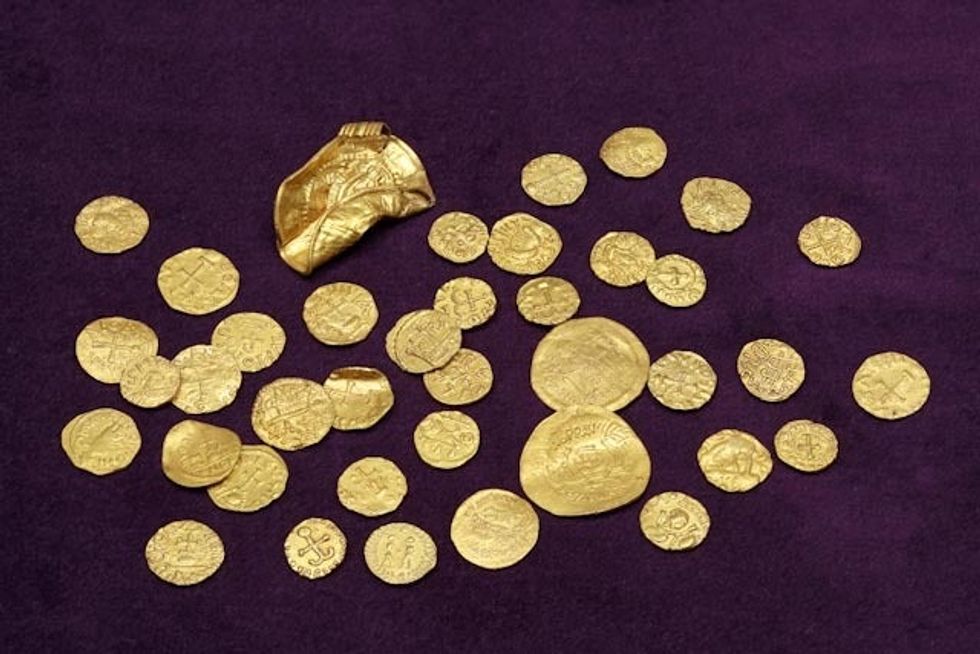
Metal detectorists have unearthed the largest hoard of Anglo-Saxon gold coins to be discovered in England to date.
The find of 131 gold coins, along with four other gold objects, was discovered in west Norfolk with the exact location not disclosed as the landowner requested anonymity.
Most of the items were discovered by a single detectorist, who asked to remain anonymous, between 2014 and 2020.
However, 10 of the coins were found by a second detectorist, serving police officer David Cockle, who failed to report his discovery and tried to sell them.
His deception was discovered and the then 50-year-old was sentenced in 2017 to 16 months in prison after admitting theft.
He was also dismissed from the police.
Two of the 10 coins could not be recovered as they had already been sold and had disappeared into the antiquities trade.
A treasure inquest into the 1,400-year-old hoard, buried shortly after 600AD, was opened in Norwich on Wednesday.
Most of the coins are Frankish tremisses, and there are also nine gold solidi, a larger coin from the Byzantine empire worth three tremisses.
The hoard also contains four other gold objects, including a gold bracteate, which is a type of stamped pendant, a small gold bar, and two other pieces of gold that were probably parts of larger items of jewellery.
At the point when the hoard was buried, England was not yet unified but divided into several smaller Anglo-Saxon kingdoms.
Of these, the Kingdom of the East Angles, including modern Norfolk and Suffolk was one of the most important.
This region is also one of the most productive in terms of finds of archaeological material through metal detecting.
The previous largest hoard of coins of this period was a purse containing 101 coins discovered at Crondall in Hampshire in 1828.
It had been disturbed before discovery and may originally have included more coins.
The most famous discovery from this period was the ship burial from Sutton Hoo in Suffolk, recently dramatised in the Netflix movie The Dig, and dating somewhere between 610AD and 640AD.
The Sutton Hoo burial included a purse of 37 gold coins, three blank gold discs of the same size as the coins and two small gold ingots, as well as many other gold items.
Gareth Williams, curator of Early Medieval Coins at the British Museum, said: “This is a hugely important find.
“It is close in date to the famous ship burial from Sutton Hoo in Suffolk, and although it doesn’t contain as much gold as the whole of the Sutton Hoo burial, it contains many more coins.
“In fact, it is the largest coin hoard of the period known to date.
“It must be seen alongside other recent finds from East Anglia and elsewhere, and will help to transform our understanding of the economy of early Anglo-Saxon England.”
Norwich Castle Museum hopes to acquire the hoard, with the full support of the British Museum.
Tim Pestell, senior curator of archaeology at Norwich Castle Museum and Art Gallery, said: “This internationally significant find reflects the wealth and continental connections enjoyed by the early Kingdom of East Anglia.
“Study of the hoard and its findspot has the potential to unlock our understanding of early trade and exchange systems and the importance of west Norfolk to East Anglia’s ruling kings in the seventh century.”
Helen Geake, finds liaison officer for Norfolk, said: “The west Norfolk hoard is a really remarkable find, which will provide a fascinating counterpart to Sutton Hoo at the other end of the Kingdom of East Anglia.
“It underlines the value of metal-detected evidence in helping reconstruct the earliest history of England, but also shows how vulnerable these objects are to irresponsible collectors and the antiquities trade.”
















